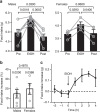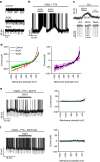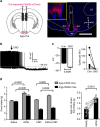Agrp neuron activity is required for alcohol-induced overeating
- PMID: 28072397
- PMCID: PMC5234092
- DOI: 10.1038/ncomms14014
Agrp neuron activity is required for alcohol-induced overeating
Erratum in
-
Corrigendum: Agrp neuron activity is required for alcohol-induced overeating.Nat Commun. 2017 May 19;8:15668. doi: 10.1038/ncomms15668. Nat Commun. 2017. PMID: 28524848 Free PMC article.
Abstract
Alcohol intake associates with overeating in humans. This overeating is a clinical concern, but its causes are puzzling, because alcohol (ethanol) is a calorie-dense nutrient, and calorie intake usually suppresses brain appetite signals. The biological factors necessary for ethanol-induced overeating remain unclear, and societal causes have been proposed. Here we show that core elements of the brain's feeding circuits-the hypothalamic Agrp neurons that are normally activated by starvation and evoke intense hunger-display electrical and biochemical hyperactivity on exposure to dietary doses of ethanol in brain slices. Furthermore, by circuit-specific chemogenetic interference in vivo, we find that the Agrp cell activity is essential for ethanol-induced overeating in the absence of societal factors, in single-housed mice. These data reveal how a widely consumed nutrient can paradoxically sustain brain starvation signals, and identify a biological factor required for appetite evoked by alcohol.
Conflict of interest statement
The authors declare no competing financial interests.
Figures




References
-
- St Diadochos of Photiki. in The Philokalia. Volume 1 (Faber and Faber, New York (1979).
-
- Yeomans M. R. Alcohol, appetite and energy balance: is alcohol intake a risk factor for obesity? Physiol. Behav. 100, 82–89 (2010). - PubMed
-
- Gatineau M. & Mathrani S. Obesity and alcohol: an overview. Available at http://www.noo.org.uk/uploads/doc/vid_14627_Obesity_and_alcohol.pdf (Public Health England, National Obesity Observatory (NOO), 2012).
-
- International Aliance for Responsible Drinking (IARD) Health Review: Drinking and Obesity, 2016. Available at http://www.iard.org/wp-content/uploads/2016/02/HR-Obesity1.pdf.
Publication types
MeSH terms
Substances
Grants and funding
LinkOut - more resources
Full Text Sources
Other Literature Sources
Molecular Biology Databases

